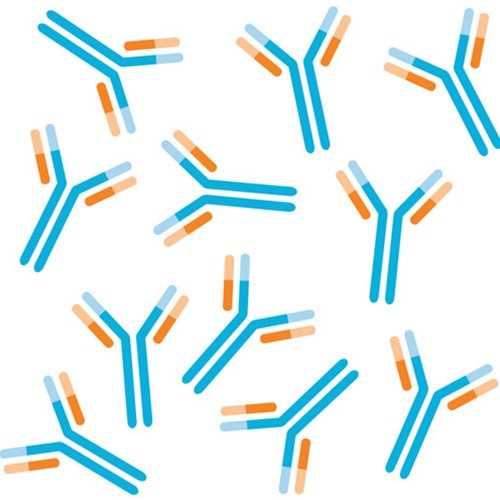Anti-DDB1 Antibody
This rabbit polyclonal antibody was generated against a synthetic peptide corresponding to amino acids 198-213 of human damage-specific DNA binding protein 1 (DDB1) and recognizes human and mouse DDB1.
Highlights:
- Reacts with human and mouse DDB1
- Suitable for Western Blot, ELISA, and Immunoprecipitation applications
DDB1 is also known as damage-specific DNA binding protein 1, DDB p127 subunit, DDBa, UV-damaged DNA-binding protein 1, UV-DDB 1, Xeroderma pigmentosum group E complementing protein, XPCe, X-associated protein 1 and XAP-1. The DDB1 gene encodes the large subunit (p127) of DNA damage-binding protein, which is a heterodimer, composed of a large and a small subunit (p48 DDB2). This nuclear protein functions in nucleotide-excision repair resulting from UV-damaged DNA by binding to pyrimidine dimers. Its defective activity causes the repair defect in the patients with xeroderma pigmentosum complementation group E (XPE). XP-E is a rare human autosomal recessive disease characterized by solar sensitivity, high predisposition for developing cancers on areas exposed to sunlight and, in some cases, neurological abnormalities. DDB1 antibody is involved in Epigenetic and Cancer/DNA Damage research.
From the laboratory of Yue Xiong, PhD, University of North Carolina Chapel Hill.
This rabbit polyclonal antibody was generated against a synthetic peptide corresponding to amino acids 198-213 of human damage-specific DNA binding protein 1 (DDB1) and recognizes human and mouse DDB1.
Highlights:
- Reacts with human and mouse DDB1
- Suitable for Western Blot, ELISA, and Immunoprecipitation applications
DDB1 is also known as damage-specific DNA binding protein 1, DDB p127 subunit, DDBa, UV-damaged DNA-binding protein 1, UV-DDB 1, Xeroderma pigmentosum group E complementing protein, XPCe, X-associated protein 1 and XAP-1. The DDB1 gene encodes the large subunit (p127) of DNA damage-binding protein, which is a heterodimer, composed of a large and a small subunit (p48 DDB2). This nuclear protein functions in nucleotide-excision repair resulting from UV-damaged DNA by binding to pyrimidine dimers. Its defective activity causes the repair defect in the patients with xeroderma pigmentosum complementation group E (XPE). XP-E is a rare human autosomal recessive disease characterized by solar sensitivity, high predisposition for developing cancers on areas exposed to sunlight and, in some cases, neurological abnormalities. DDB1 antibody is involved in Epigenetic and Cancer/DNA Damage research.
From the laboratory of Yue Xiong, PhD, University of North Carolina Chapel Hill.
| Product Type: | Antibody |
| Name: | Anti-DDB1 Antibody |
| Antigen: | DDB1 |
| Accession ID: | Q16531 |
| Molecular Weight: | A 127.0 kDa band corresponding to human DDB1 is detected. |
| Clonality: | Polyclonal |
| Reactivity: | Human and mouse DDB1 |
| Immunogen: | DDB1 antibody was prepared from whole rabbit serum produced by repeated immunizations with a synthetic peptide corresponding to amino acids 198-213 of Human DDB1 (internal) coupled to KLH. |
| Epitope: | Amino acids 198-213 of Human DDB1 (internal) |
| Buffer: | Serum with 0.01% (w/v) Sodium Azide |
| Tested Applications: | Western Blot: 1:500 - 1:1,000; ELISA: 1:2,000 - 1:10,000; ImmunoPrecipitation: 1:500 |
| Storage: | Store serum at -20° C prior to opening. Aliquot contents and freeze at -20° C or below for extended storage. Avoid cycles of freezing and thawing. Centrifuge product if not completely clear after standing at room temperature. This product is stable for several weeks at 4° C as an undiluted liquid. Dilute only prior to immediate use. |
| Shipped: | Cold Packs (Domestic, Overnight); Dry Ice (International) |
Western Blot

Anti-DDB1 antibody reacts with human and mouse DDB1 by western blot and immunoprecipitation. The antibody immunoprecipitates in vitro translated protein and protein from cell lysates (using HeLa, NIH-3T3, and others). Coimmunoprecipitation of related proteins has not been tested. A 127.0 kDa band corresponding to human DDB1 is detected. Most cell lines expressing DDB1 can be used as a positive control. Researchers should determine optimal titers for other applications.
The protein encoded by this gene is the large subunit (p127) of the heterodimeric DNA damage-binding (DDB) complex while another protein (p48) forms the small subunit. This protein complex functions in nucleotide-excision repair and binds to DNA following UV damage.
- Shiyanov et al., (1999). Mol. Cell Biol. 19:4935-4943.
- Shiyanov et al. (1999). J. Biol. Chem. 274:35309-35312.
- Ohta, T., Michel J.J., Schottelius A. J., and Xiong Y. (1999) Molecular Cell 3:535-541.
- Ohta. T, Michel JJ, Xiong Y. (1999). Oncogene 18:6758-66.
- Ohta, T. and Xiong, Y. (2001). Cancer Res. 61:1347-1353.
- Hu et al. (2004) Nature Cell Biol 6: 1003-1010.
- Hu et al. (2006) Journal of Biol Chem 281: 3753-3756.
- He et al. (2006) Genes & Dev. 20: 2949-2954.
- Hu et al. (2008) Genes & Dev. 22: 866.
- McCall et al. (2008) Mol and Cell Biol. 28: 5621-33.
- Kotake et al. (2009) Cancer Res. 69:1809-14.
- Nakagawa et al. (2011) Mol Cell 43: 381-91.
- Nakagawa et al. (2015) Mol Cell 57: 247-60.
- Zha et al. (2015) Mol Cell 58: 794-803.
- Groh et al. (2016) EMBO Rep e201540500.
If you publish research with this product, please let us know so we can cite your paper.


